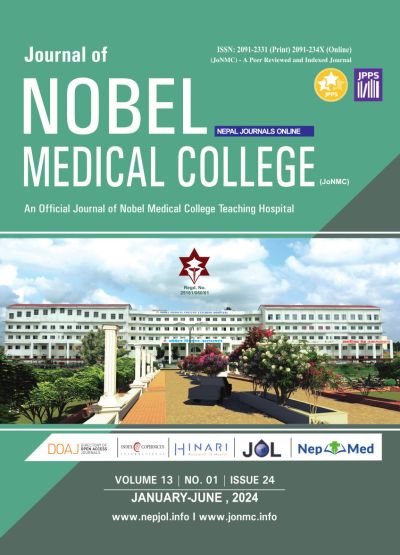Profile and Visual Outcome of Patients having Keratoconus Attending Tertiary Eye Hospital, Nepal
DOI:
https://doi.org/10.3126/jonmc.v13i1.68100Keywords:
Contact lens, Keratoconus, Patients, Nepal, Visual outcomeAbstract
Background: Keratoconus is a bilateral, asymmetric, chronic, progressive ectasia of the cornea in which patients experience distorted vision that is usually treated with rigid contact lenses when spectacles no longer provide adequate vision. The aim of the study is to find out the clinical profile and visual outcome of the patient having Keratoconus.
Materials and Methods: The hospital based cross sectional study was done at Biratnagar Eye Hospital, Biratnagar. All the diagnosed Keratoconus patients referred from cornea clinic to contact lens clinic for contact lens trial were included in this study between 1stJanuary 2017 to 31st December 2019. Diagnosis was done by using keratometry and pachymetry findings or by using corneal topography findings and slit lamp examination.
Results: Total 133 patients were enrolled in the study among them the mean (±SD) age was 20.2 (±6.9) with a minimum of 9 and a maximum of 50 years of age. Most of them were male 89 (67%) and 78 (58.7%) patients were between 16 to 25 years of age group. Most of the eyes had moderate 161 (63.4%) type in which the amount of refractive was high 201 (79%) and RGP contact lens 245 (96.4%) was tried for vision correction. Normal vision (0.0 to 0.5 Log MAR) was found in 255 (96%) of eyes among them 194 (73%) of eyes got better than 0.2 log MAR visual acuity after the contact lens trial.
Conclusion: Keratoconus was found mostly in younger male patients and gas permeable contact lenses were most commonly used treatment modality.
Downloads
Downloads
Published
How to Cite
Issue
Section
License

This work is licensed under a Creative Commons Attribution 4.0 International License.
JoNMC applies the Creative Commons Attribution (CC BY) license to works we publish. Under this license, authors retain ownership of the copyright for their content, but they allow anyone to download, reuse, reprint, modify, distribute and/or copy the content as long as the original authors and source are cited.




